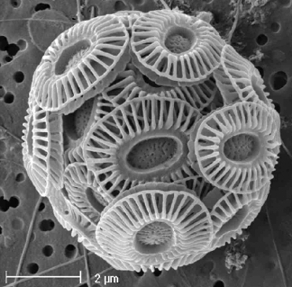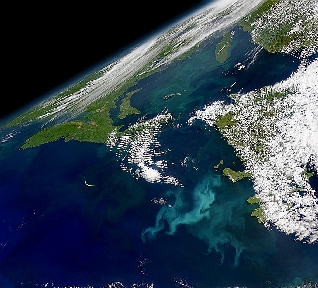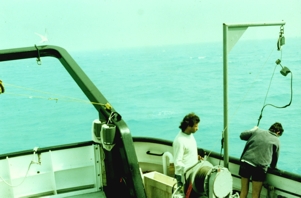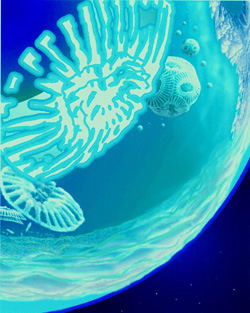



Emiliania huxleyi Home Page
Welcome to the home page for "Ehux"


Introduction to Emiliania huxleyi (Ehux)
What links country-sized patches of bright turquoise water in the oceans,
CO2 concentrations in the atmosphere, and the white cliffs of Dover? The
answer is an armour-plated, photosynthesising single-celled creature, so
small that it is invisible to the naked eye and is barely discernible under
a light microscope. With it's beautiful appearance and its planetary
importance, Emiliania huxleyi is a source of interest for all those
looking to understand how life and its environment interact.

Picture courtesy of
Jess Gorick
(copyright held).
Phytoplankton: Emiliania huxleyi is one of 5000 or so
different species of phytoplankton - freely drifting, photosynthesising
microscopic organisms that live in the upper, sunlit layers of the ocean.
Phytoplankton are the oceanic equivalents of terrestrial plants, forming the
basis of virtually all marine food webs. The total phytoplankton biomass
outweighs that of all the marine animals (zooplankton, fish, whales) put
together, and phytoplankton productivity is one of the primary forces in
regulating our planetary climate - for instance via impacts on atmospheric
carbon dioxide levels which are tightly linked to the oceanic
concentrations.
Coccolithophores: The peculiar, and beautiful, armoured appearance of
the Ehux cells is due to their possession of calcium carbonate
platelets
(
coccoliths)
used to cover the exterior of the cell. We don't yet know exactly why the
cells secrete these small shields around themselves, although many
hypotheses have been put forward. Coccolith-bearing phytoplankton species,
of which Ehux is just one, are called coccolithophores.
Occurrence: Ehux is by far the most abundant of the
coccolithophores on a global basis, and is extremely widespread, occurring
in all except the polar oceans. When water conditions are favourable, it
has the capacity to occur in massive blooms, sometimes > 100,000 square
kilometres (the size of England) in extent. During these blooms the numbers
of Ehux cells usually outnumber those of all other species combined,
frequently accounting for 80 or 90% or more of the total number of
phytoplankton cells in the water. The cells are accompanied by even larger
numbers of coccoliths; many of them attached to the cells but also many
floating separately in the water. The freely floating coccoliths are
thought to arise due to over-production of coccoliths leading to the
synthesis of more than can be securely held on the cell surface. Other
possible causes are death of the cell after which the empty coccospheres
disintegrate, and asexual cell division after which the coccosphere must
presumably break open to let out one or both of the two inhabitants.
Ehux may well be unique amongst the coccolithophores in its
generation of so many free coccoliths.

Why the interest in Emiliania huxleyi?
History: Partly of course because of the exquisite beauty of the
coccolith-laden cells
(pictures),
which, because of their small size, have only been appreciated since
electron microscopes were developed in the early 1950's. Before that the
Ehux cells and coccoliths were only apparent as faint smudges under
light microscopes.
Thomas Henry Huxley
("Darwin's bulldog") was one of the first to examine sea-bottom mud and to
detect coccoliths within it, and the first to use the term "coccolith". In
turn the species Emiliania huxleyi is named after him.
Ehux is also interesting because its blooms produce a marked change
in the appearance of the water, turning it a milky turquoise colour during
intense blooms. These blooms are particularly prevalent in Norwegian fjords
such as the Oslo fjord, discolouring the water and perturbing the
environment for other organisms, and affecting bathing conditions. The
cause of the "white waters" pictured above (click
here
for more) occasionally seen in the oceans was for a long time a mystery
(quote),
until coccolithophores such as Ehux were discovered as the culprits.
White waters: We now understand further that these white waters are
brought about by the coccoliths (not the organic cells themselves) which act
like minute (smaller than pinhead-sized) mirrors suspended in the water.
En masse they cause a significant amount of the incoming sunlight to
be reflected back out of the water. Water containing large amounts of
coccoliths is optically similar to water if sackloads of glitter or sequins
were to be added to it. This property of the blooms makes Ehux
uniquely accessible to scientific investigation - the reflectance from the
blooms can be picked up by satellites in space, allowing the extent of the
blooms of this single species to be distinguished in fine detail. The
presence of chlorophyll in the water can be detected by satellite, but this
does not tell us which individual phytoplankton species or set of species is
responsible. In contrast, the presence of coccoliths can be detected
separately, delineating precisely the extent of a coccolithophore bloom:
[satellite pictures of blooms]
[space shuttle pictures of blooms]

Picture courtesy of
Glynn Gorick
(copyright held).
Global aspects
Distribution: These satellite pictures give us a special insight into
the world-wide biogeography of this species, and a groundbreaking
study
has analysed CZCS satellite images from all over the globe to give us an
idea of the global distribution of Ehux.
Biogeochemistry: A final reason for the interest in Ehux
is its global significance. The coccolith bloom areas are highly
reflective, causing more light and heat to be reflected back out to space
rather than heating the ocean. The construction of huge numbers of
coccoliths from calcium and carbon, and their subsequent sinking to the
ocean floor, also perturbs the ocean carbon system and eventually makes a
difference to the amount of CO2 that can be stored in the atmosphere to
contribute to the CO2 greenhouse effect. As well as exerting an impact on
climate change, the long-term flux of coccoliths to the ocean floor goes to
form chalk and limestone rocks - for instance the white cliffs of Dover are
in large part made up of coccoliths that fell to the sea bed many millions
of years ago. You are probably standing over many metres of
coccolith-composed rocks as you read this.
Links to specific topics:
Vital Statistics
Cellular description
Life cycle
Ecology
Biogeography
Coccoliths
Optical effects
Biogeochemical impacts
Geological context & evolutionary origins
Grim future for Ehux?
Bibliographies of Ehux research
Global Emiliania Modelling (GEM) initiative
Links
Credits

Toby Tyrrell : T.Tyrrell@noc.soton.ac.uk









